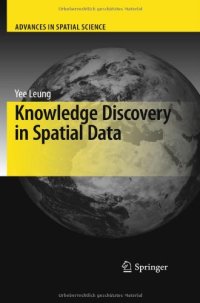
Ebook: Knowledge Discovery in Spatial Data
Author: Yee Leung (auth.)
- Genre: Science (General)
- Tags: Regional/Spatial Science, Quantitative Geography
- Series: Advances in Spatial Science
- Year: 2009
- Publisher: Springer-Verlag Berlin Heidelberg
- Edition: 1
- Language: English
- pdf
This book deals with knowledge discovery and data mining in spatial and temporal data, seeking to present novel methods that can be employed to discover spatial structures and processes in complex data. Spatial knowledge discovery is examined through the tasks of clustering, classification, association/relationship, and process. Among the covered topics are discovery of spatial structures as natural clusters, identification of separation surfaces and extraction of classification rules from statistical and algorithmic perspectives, detecting local and global aspects of non-stationarity of spatial associations and relationships, unraveling scaling behaviors of time series data, including self-similarity, and long range dependence. Particular emphasis is placed on the treatment of scale, noise, imperfection and mixture distribution. Numerical examples and a wide scope of applications are used throughout the book to substantiate the conceptual and theoretical arguments.
This book deals with knowledge discovery and data mining in spatial and temporal data, seeking to present novel methods that can be employed to discover spatial structures and processes in complex data. Spatial knowledge discovery is examined through the tasks of clustering, classification, association/relationship, and process. Among the covered topics are discovery of spatial structures as natural clusters, identification of separation surfaces and extraction of classification rules from statistical and algorithmic perspectives, detecting local and global aspects of non-stationarity of spatial associations and relationships, unraveling scaling behaviors of time series data, including self-similarity and long range dependence. Particular emphasis is placed on the treatment of scale, noise, imperfection and mixture distribution. Numerical examples and a wide scope of applications are used throughout the book to substantiate the conceptual and theoretical arguments.